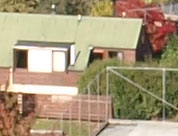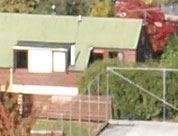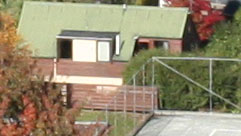Olympus E-420
-
-
Written by Gordon Laing
Olympus E-420 vs Canon EOS 400D / XTi vs EOS 450D / XSi real-life noise
Olympus E-420 Noise Filter comparisonThe Olympus E-420 offers four different noise filter settings, Off, Low, Standard and High, so we shot the same scene with each setting to compare their differences. As seen with previous Olympus DSLRs, there’s quite a difference between the settings. With the Noise Filter switched off in the first column, there’s unsurprisingly the greatest noise visible, but equally there’s little or no smearing of detail due to aggressive noise reduction. With the Noise Filter set to Low, there’s a reduction in visible noise, but equally an increase in softness. At the Standard setting, noise has virtually been eliminated, but at the cost of greater smearing. Then with the Noise Filter set to High, there’s a noticeable compromise in detail, albeit without any of those pesky noise speckles. Like the other Olympus bodies before it, we’d say the milder Noise Filters are actually preferable to the Standard setting at high sensitivities. There’s certainly more fine detail visible even through the noise speckles, and remember you can always apply more sophisticated noise reduction to your exact tastes using software later. The important thing is there’s retrievable detail if you’re willing to turn down the Noise Filter. So if you’re willing to post-process or aren’t bothered by noise speckles, then you may wish to try switching the Noise Filter off altogether. But if you’d like a good compromise in-camera, then the Low setting will hang onto more detail than the default Standard setting. Now to see more real-life examples across its sensitivity range, including indoor shots under low light, check out our Olympus E-420 Gallery. |
Olympus E-420 Noise Filter: Off |
Olympus E-420 Noise Filter: Low |
Olympus E-420 Noise Filter: Standard |
Olympus E-420 Noise Filter: High | |||
 |
 |
 |
 | |||
100 ISO |
100 ISO |
100 ISO |
100 ISO | |||
 |
 |
 |
 | |||
200 ISO |
200 ISO |
200 ISO |
200 ISO | |||
 |
 |
 |
 | |||
400 ISO |
400 ISO |
400 ISO |
400 ISO | |||
 |
 |
 |
 | |||
800 ISO |
800 ISO |
800 ISO |
800 ISO | |||
 |
 |
 |
 | |||
1600 ISO |
1600 ISO |
1600 ISO |
1600 ISO |
Olympus E-420 results
 |
 |
To compare noise levels under real-life conditions we shot this scene with the Olympus E-420, Canon EOS 400D / XTi and EOS 450D / XSi within a few moments of each other using each of their ISO settings in Aperture Priority modes. The lenses on each camera were adjusted to deliver the same vertical field of view – see note below.
The E-420 was fitted with the Zuiko Digital 25mm f2.8 and both Canon’s with their respective EF-S 18-55mm kit lenses.
The image left was taken with the Olympus E-420 and the 25mm pancake lens at f8 and with a sensitivity of 100 ISO; the original JPEG measured 3.83MB. The crops are taken from an area roughly in the middle of the image and presented here at 100%.
Note: The Olympus E-420, like all Four Thirds DSLRs, captures images with a 4:3 aspect ratio that’s narrower than the 3:2 aspect ratio of most DSLRs including both Canon models here. In this test we adjusted the lenses on the Canons to deliver the same vertical field of view as the E-420 with its 25mm lens, so we’re not using the full width of the Canon images. As such, the 400D / XTi and 450D / XSi are only using 8.9 and 10.8 of their total Megapixels here respectively.
Also note we matched the Canon exposures to those metered by the Olympus. Judging from the full image above, this exposure was fine overall, but the cropped area used for comparison below appears slightly over-exposed.
At 100 and 200 ISO, the E-420 delivers a good degree of detail, and comfortably more than the Canon EOS 400D / XTi – this is particularly apparent in the foliage of the trees and bushes. At 400 ISO, some noise and processing has crept in, but it the output remains respectable, and again ahead of what the 400D / XTi is delivering.
At 800 and 1600 ISO, there’s a bigger drop in quality, but from the crops below, the E-420 still manages to keep up with the results delivered by both Canon bodies. To see more real-life examples across its sensitivity range, including several taken indoors under low light, check out our Olympus E-420 Gallery. Alternatively, take a moment to first scroll to the bottom of this page to check out the impact of the E-420’s different Noise filter settings – you may much prefer the output from one over the default setting.
Olympus E-420 with Zuiko Digital 25mm |
Canon EOS 400D / XTi with Canon EF-S 18-55mm |
Canon EOS 450D / XSi with Canon EF-S 18-55mm IS | ||
 |
 |
 | ||
100 ISO |
100 ISO |
100 ISO | ||
 |
 |
 | ||
200 ISO |
200 ISO |
200 ISO | ||
 |
 |
 | ||
400 ISO |
400 ISO |
400 ISO | ||
 |
 |
 | ||
800 ISO |
800 ISO |
800 ISO | ||
 |
 |
 | ||
1600 ISO |
1600 ISO |
1600 ISO |




